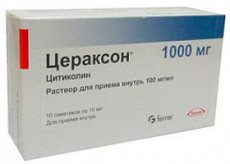Medical expert of the article
New publications
Preparations
Ceraxon
Last reviewed: 03.07.2025

All iLive content is medically reviewed or fact checked to ensure as much factual accuracy as possible.
We have strict sourcing guidelines and only link to reputable media sites, academic research institutions and, whenever possible, medically peer reviewed studies. Note that the numbers in parentheses ([1], [2], etc.) are clickable links to these studies.
If you feel that any of our content is inaccurate, out-of-date, or otherwise questionable, please select it and press Ctrl + Enter.

Ceraxon belongs to the pharmacological group of drugs with nootropic and psychostimulating effects on the central nervous system and is a means of improving the metabolism of brain cells. ATX code - N06B X06.
Other trade names: Citicoline, Citimax, Cytocon, Neuroxon, Neocebron, Diphosphocin, Somazina.
Indications Ceraxon
The drug Ceraxon is used to treat neurological complications and reduce the severity of the consequences of acute cerebrovascular accidents due to ischemic or hemorrhagic stroke, traumatic brain injury (accompanied by diffuse axonal damage to the brain).
Ceraxon is also intended for the correction of mental, sensory and motor disorders (including dementia, extrapyramidal syndromes, amnesia, etc.) caused by neurosurgical interventions and various latent degenerative encephalopathies.
Release form
Pharmacodynamics
The neuroprotective effect of the drug Ceraxon is provided by the active pharmacological substance cytylcoline, which is an analogue of the natural nucleoside phosphate cytidine 5-diphosphocholine - a precursor of lecithin molecules (phosphatidylcholine) and other phospholipids of the cell membranes of neurons and neuroglia.
By integrating into brain cells and supplying them with choline, which is necessary for the production of the neurotransmitter acetylcholine, Ceraxon promotes the activation of acetylcholine synthesis (which decreases under conditions of cerebral ischemia), participates in the production of endogenous phospholipids of cell membranes, improves the supply of oxygen to cells, reduces cerebral edema, and also prevents lipid peroxidation of brain tissue cells.
As a result, the stability of dopaminergic nerve cell membranes increases, which leads to the normalization of cerebral metabolism. In addition, the effect of citicoline increases the content of dopamine and increases the sensitivity of its receptors, which are responsible for the most important functions of the central nervous system: motivation, attention, memory, cognitive abilities, fine motor coordination, etc.
 [ 4 ]
[ 4 ]
Pharmacokinetics
After parenteral administration of Ceraxon or oral administration of the solution, citicoline enters the systemic bloodstream; bioavailability is almost 99% (regardless of the form of the drug used). The maximum concentration of the drug in plasma is observed 60 minutes after administration, and after 24 hours the concentration reaches a second peak.
In the blood serum or in the small intestine, the active substance Ceraxon undergoes hydrolysis to produce choline and cytidine, which enter the brain and are included in the process of producing endogenous cytidine 5-diphosphocholine.
Biotransformation of Ceraxon occurs in the liver and intestines, the free choline formed in this process is involved in the production of lecithin and membrane lipids.
Cetylcoline is eliminated from the body in two stages, mainly through the respiratory tract and, partly, through the kidneys with urine.
Dosing and administration
The dosage of Ceraxon and the duration of its use depend on the severity of brain damage in each individual case.
The drug is administered intramuscularly - 0.5-1 ml twice a day; the maximum daily dose is 20 ml. The course of treatment can last from two weeks to a month or three months.
In acute conditions, Ceraxon can be administered intravenously by drip – 40-60 drops/min.
The dosage of the oral solution is calculated individually for each patient; the maximum duration of oral administration of Ceraxon is three months.
 [ 7 ]
[ 7 ]
Use Ceraxon during pregnancy
Since the use of this drug during pregnancy and lactation has been little studied, its use in the treatment of pregnant and lactating women is permitted only if the possible benefit to the mother outweighs the potential risks to the normal development of the fetus and the health of the child.
Contraindications
Contraindications to the use of the drug Ceraxon are individual hypersensitivity to cetylcoline and the presence of vagotonic disorders associated with increased tone of the parasympathetic nervous system.
Side effects Ceraxon
The use of the drug Ceraxon may cause side effects in the form of skin allergic reactions, headaches, dizziness, hyperhidrosis, fever, nausea, decreased blood pressure, increased heart rate, shortness of breath, and the appearance of hallucinations.
The possibility of developing angioedema or anaphylactic shock cannot be ruled out.
Overdose
Interactions with other drugs
It should be borne in mind that the simultaneous use of Ceraxon with the antiparkinsonian drug Levodopa enhances the effect of the latter.
Ceraxon is incompatible with antihypertensive drugs, as well as with CNS stimulants that contain meclofenoxate (Acefen, Centroxin, Cerutil, Analux, Claretil, Mexazine, etc.)
Shelf life
The shelf life of the drug is 36 months.
 [ 14 ]
[ 14 ]
Attention!
To simplify the perception of information, this instruction for use of the drug "Ceraxon" translated and presented in a special form on the basis of the official instructions for medical use of the drug. Before use read the annotation that came directly to medicines.
Description provided for informational purposes and is not a guide to self-healing. The need for this drug, the purpose of the treatment regimen, methods and dose of the drug is determined solely by the attending physician. Self-medication is dangerous for your health.

